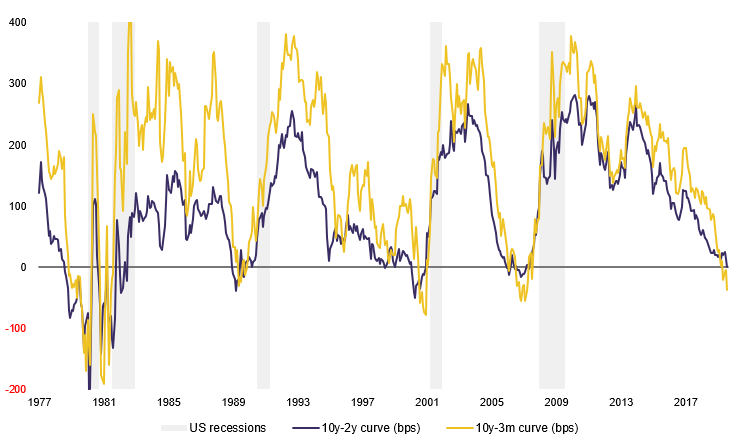Wealth Management: Strategy blog – Market Signals

Strategy team - Victor Balfour (Wealth Management)
August has now seen two 3% sell-offs in the US equity market, and new lows in many bond yields, as heightened trade, geopolitical and cyclical tensions have hit risk appetite.
Yesterday's move followed further signs of slowing growth in China and Germany, and a further “inversion” of the US yield curve (the difference between the yield on the US 10 year treasury yield and 2 year treasury has now turned negative).
The yield curve shows how the levels of yields varies according to the term of the borrowing. Normally it slopes upwards, with longer-dated borrowing costs exceeding short-term rates and yields. When that gap turns negative, the curve is said to “invert”, and such an event is credited by many analysts with near-mystical predictive powers. Some segments of the yield curve are deemed more important than others.
Historically, when the gap between 10-year and 2-year yields - one of the more widely-watched segments of the curve - enters negative territory it has preceded a recession: the last five such inversions have eventually led to such an outcome (see chart below). Recession has not followed immediately, however: there has been an average lag of 22 months. And this is not always a sell signal for stocks: the S&P 500 is typically up 12% in the 12 months that follow an inversion.
US yield curves and recessions (Jan '77 to Aug ' 19)
Click the image to enlarge
But correlation is not causation.
As we have noted before the power of the bond market to predict economic recessions is not infallible - the root causes of recessions have varied enormously, and indeed taking a longer post-WWII dataset the yield curve's track record looks less conclusive, with inversions having predicted only 7 of the last 9 recessions. Importantly, flat or inverting yield curves have been a more immediate signal in periods of high inflation (reflecting the risk of overly tight monetary policy in such an environment).
Related to that inflationary context, in previous inversions, nominal treasury yields have typically exceeded nominal GDP growth - arguably a signal of more restrictive monetary conditions. With nominal borrowing costs now well below nominal growth rates, it could be argued that such conditions currently are hardly an impediment to growth.
With one-third of global investment grade debt now trading on a negative yield, for yield-starved international investors, the appeal of longer-dated US treasuries should not be underestimated: the US curve may be attracting buyers not just because economic risk is rising, but partly because long-dated US yields are the only positive yields left in town, as it were. Some of the flatness (or inversion) may also simply be due to technical factors: much of the free float of government bonds these days is locked away in central bank vaults, which may have supressed the “term premium”.
It is also possible that there is a more structural issue at play in today's bond markets: we've written recently about the way in which growth, inflation and interest rates interact may be up for grabs. Meanwhile, whatever stocks are worrying about, they should not place too much near-term emphasis on the signals seemingly coming from the bond market: its forecasting ability has not been that precise, and it may be just a little cranky of late.
More broadly, stock market volatility now is not a big surprise. If anything, stocks had been a little stronger this summer than we'd have expected. August's setback is following a new all-time high for the US index just three weeks ago, and the S&P 500 is still up 13% year-to-date (global stocks are up roughly 10% in dollars). We do not yet think US or global recession is imminent, and we doubt that interest rates and the yield curve will stay quite this low for long. But the very visible economic risks - particularly those around trade - seem likely to be with us for a while, and stocks had used up a lot of headroom.
Disclaimer
Past performance is not a guide to future performance and nothing in this blog constitutes advice. Although the information and data herein are obtained from sources believed to be reliable, no representation or warranty, expressed or implied, is or will be made and, save in the case of fraud, no responsibility or liability is or will be accepted by Rothschild & Co Wealth Management UK Limited as to or in relation to the fairness, accuracy or completeness of this document or the information forming the basis of this document or for any reliance placed on this document by any person whatsoever. In particular, no representation or warranty is given as to the achievement or reasonableness of any future projections, targets, estimates or forecasts contained in this document. Furthermore, all opinions and data used in this document are subject to change without prior notice.
